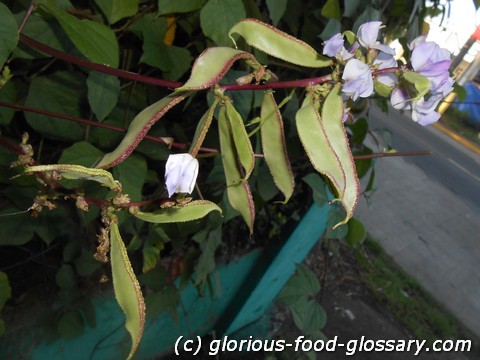English: Describe / Deutsch: Beschreiben / Español: Describir / Português: Descrever / Français: Décrire / Italiano: Descrivere /
In the food context, "Batao" refers to a type of bean commonly used in Filipino cuisine, also known as the hyacinth bean or lablab bean (Lablab purpureus). This Legume is recognized for its edible pods and seeds, which are utilized in a variety of dishes across the Philippines and other parts of Asia and Africa. The batao bean is valued not only for its nutritional content but also for its versatility in cooking.
Culinary Uses:
- Young Pods: The tender, young pods of the batao can be cooked similarly to green beans and are often added to soups, stews, and mixed vegetable dishes.
- Seeds: Mature batao seeds are dried and can be boiled or cooked like other beans. However, it's important to note that they should be properly cooked to neutralize any potentially harmful substances.
- Leaves: In some regions, the leaves of the batao plant are also consumed, either cooked as a green vegetable or used in salads.
Nutritional Aspects:
Batao beans are a good source of protein, fiber, vitamins (such as vitamin A and vitamin C), and minerals (including iron and potassium). Like other legumes, they can be a nutritious addition to the diet, contributing to overall health and well-being.
Cultural Significance:
In Filipino cuisine, batao is used in traditional dishes that reflect the country's agricultural heritage and culinary diversity. The bean is appreciated for its ability to grow in various conditions and its contribution to food security in rural communities.
Preparation and Safety:
When preparing batao, especially the seeds, it's crucial to cook them thoroughly to ensure they are safe for consumption. The mature seeds contain compounds that can be harmful if ingested in large quantities or if not properly processed.
Summary
Batao, or hyacinth bean, is a versatile and nutritious legume found in Filipino cuisine and other Asian and African culinary traditions. Its young pods, seeds, and sometimes leaves are used in a variety of dishes, offering both flavor and nutritional benefits. Proper preparation is essential to enjoy batao safely and make it a valuable part of a balanced diet.
--
Referred Picture:

Related Articles to the term 'Batao' | |
| 'Bataw' | ■■■■■■■■■■ |
| In the food context, \'Bataw\' refers to the hyacinth bean or lablab bean (Lablab purpureus), similar . . . Read More | |
| 'Nilagang Gabi' | ■■■■■ |
| Nilagang Gabi in the food context refers to a Filipino dish involving boiled taro (gabi) root. Taro is . . . Read More | |
| 'Ginisang Gulay' | ■■■■ |
| Ginisang Gulay in the food context refers to a Filipino dish consisting of sautéed vegetables. It is . . . Read More | |
| 'Green Beans' | ■■■■ |
| Green Beans, in the food context, refer to the unripe or young pods of the bean plant that are consumed . . . Read More | |
| 'Loofah' | ■■■■ |
| Loofah in the food context refers to the edible fruit of plants in the genus Luffa, particularly the . . . Read More | |
| 'Talbos' | ■■■ |
| Talbos is the Filipino generic name for \'young tips of edible leaves\', such as Talbos ng Kamote young . . . Read More | |
| 'Bean' | ■■■ |
| Bean: A bean is the seed of one of several genera of the flowering plant family Fabaceae, which are used . . . Read More | |
| 'Kasubha' | ■■■ |
| Kasubha is the dried stigmas of a plant, used for coloring and flavoring food a kind of saffron. . . . . . Read More | |
| 'Potage' | ■■■ |
| Potage refers to a type of thick and creamy soup that is typically made by simmering vegetables, grains, . . . Read More | |
| 'Paa ng Manok' | ■■■ |
| Paa ng Manok in the food context refers to chicken feet, a delicacy and common ingredient in various . . . Read More | |
